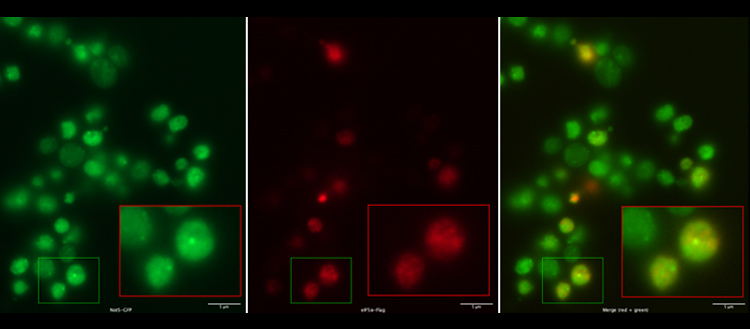How to produce proteins at the right speed
Using a dynamic observation technique of protein synthesis, scientists at UNIGE have deciphered the genetic mechanisms governing the speed of translation of messenger RNA.

Not5 condensates (on the top, in green) exclude an mRNA translation acceleration factor (visible in red, middle). On the bottom, merged staining: yellow would indicate co-localization, but condensates are green so the mRNA translation acceleration factor is absent. © ©UNIGE – Laboratoire Collart
In all eukaryotic organisms, genetic material is stored in the cell nucleus in the form of DNA. In order to be used, this DNA is first transcribed into messenger RNA in the cell cytoplasm, then translated into protein with the help of ribosomes, small machines capable of decoding messenger RNA to synthesise the appropriate proteins. However, the speed with which this mechanism takes place is not uniform: it must adapt to allow the protein to adopt the right configuration. Indeed, a deregulation of the production rate leads to structural defects. The proteins, which are not correctly folded will aggregate, become unusable and often toxic for the cell. By analysing the rate of ribosome movement in yeast cells, a team from the University of Geneva (UNIGE), Switzerland, in collaboration with the University of Hamburg, has succeeded in demonstrating that the rate of protein synthesis is modulated by regulatory factors that modify at will the rate of translation of messenger RNA into proteins. These results can be found in the journal Cell Reports.
Proteins are 3D structures that, in order to act, must interlock with each other or interact with partners. In case of a structural defect, the proteins clump together, becoming toxic and potentially pathological. This phenomenon is actually observed in many neurodegenerative diseases, such as Alzheimer’s disease or amyotrophic lateral sclerosis. “We already knew that the rate at which proteins are made varies according to need: sometimes fast, sometimes very slow”, explains Martine Collart, a professor in the Department of Microbiology and Molecular Medicine at the UNIGE Faculty of Medicine, who led this research. “However, we did not yet know how this mechanism was controlled.”
Ribosome profiling
In order to understand this process, the scientists used a very innovative and still not well-known technique: ribosome profiling. “This methodology makes it possible to determine the position of ribosomes at a given moment in the cell”, explains Olesya Panasenko, a researcher in Martine Collart’s laboratory and head of the ‘BioCode: RNA to Proteins’ Core Facility at the Faculty of Medicine, who specialized in this technique. “It consists of degrading, at a specific moment, all the RNA that is not protected by the ribosome, to keep only the ribosome protected fragments (RPFs). We then sequence these RPFs in order to define how many ribosomes were on the mRNA, and at which positions, at that particular moment. This indicates the speed and efficiency of translation.”
The scientists observed the speed and dynamics of protein production in natural yeast cells as well as in genetically modified yeast, in order to identify possible differences depending on the genetic code. During synthesis, small condensates of RNA and proteins appear in the cell, with the function of slowing down the rate of ribosome production. “The formation of these condensates depends on the presence or absence of regulatory factors, called Not, which act as decelerators”, explains Martine Collart. In their absence, the mechanism accelerates in the wrong places and results in aggregated proteins.
A speed regulated by the genetic code
Thus, Not factors associate with the ribosome at precise moments during protein synthesis, to slow down the ribosome during translation by condensing the RNA and the nascent protein. “One may wonder whether this regulatory mechanism is affected during neurodegenerative diseases or with age”, the authors ask. It is therefore possible that small disturbances, when adding one to the other, may ultimately have a significant cumulative effect over time.
